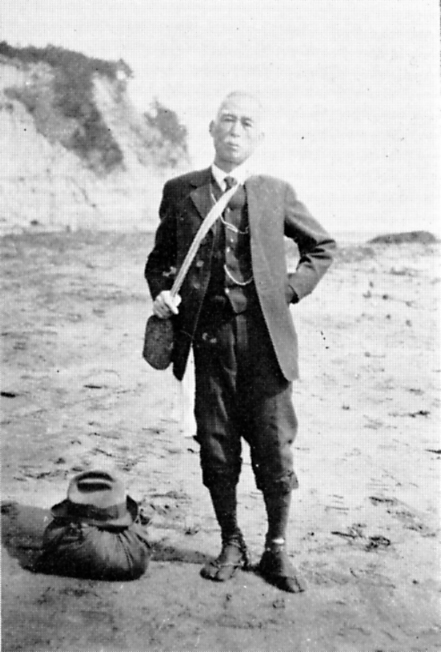Kamakura and Early Algology
Kamakura (including Enoshima*1) is a monumental place for the history of Japanese algology. In its pioneer days important botanists visited here.
In 1877, Ryokichi Yatabe (1851-1899), the first professor of botany at the University of Tokyo, made his first collection of seaweeds in Enoshima Island. Probably it was the first algal collection in Kamakura. However, unfortunately Yatabe didn't write about seeweeds because his main interests were land plants. He died early on Augast 8, 1899 in drowning accident in the sea of Kamakura at the age of 47.
Kintaro Okamura (1867-1935), who is known as "Father of Marine Botany in Japan", started his phycological works under Prof. Yatabe in 1889. After graduation, Okamura worked mainly for the Imperial Institute of Fisheries in Tokyo until 1931, clarifying approximately 1,000 species of Japanese seaweeds for the duration of his life of 68 years (Chihara 1996). In particular he collected numerous seeweeds in Sagami area and published many new taxa.
For example, from Enoshima Island 24 new species was published: e.g., Cutleria cylindrica Okamura*2, Halyseris latiuscula Okamura*3, Dudresnaya japonica Okamura, Gelidium subcostatum Okamura in Schmitz*4. Okamura's student, Yukio Yamada (1900-1975) also described a new species, Sargassum giganteifolium Yamada in Okamura from Shichirigahama.
In 1894, Samuro Ohkubo (1857-1914), who was Yatabe's assistant, and Kotaro Saida (1860-1923), who was Yatabe's first botanical student in the University of Tokyo, also collected seaweeds in Enoshima Island (May 25), Hayama (May 26) and Misaki (May 27) along Sagami Bay. Their specimens were sent to a British botanist, E. M. Holmes (1843-1930), who described 23 new species in 1896, including Cladophora ohkuboana Holmes, Codium cylindricum Holmes, Dictyopteris undulata Holmes, Glossophora coriacea Holmes*5, Padina arborescens Holmes, Chondrus elatus Holmes, Grateloupia acuminata Holmes, Grateroupia elliptica Holmes.
Likewise, many algologist have walked this area, and as a result, 50 species with type localities in this area has been found (Matsuura 2004).
References
Chihara, M. 1996. KINTARO OKAMURA. Ed. Garbary and M.J. Wynne: Prominent phycologists of the 20th Century. PSA. pp. 115-121.
Honda, M. and Hisauchi, K. 1931. Plant collection and manufacture of specimens. pp. 164. Sogokagakushuppan (in Japanese).
Matsuura 2004. Studies on the Marine algae of Sagami Bay. pp. 214. Yumekobo (in Japanese).
*1 Enoshima Island belonged to Kamakura-gun until 1947. *2=Mutimo cylindricus, *3=Dictyopteris latiuscula. *4=Ptilophora subcostata. *5=Dictyota coreacea.

Kintaro Okamura, standing on the sand beach of Shichirigahama in March 1930 (Photo:Yoshikazu Okada). He hold a thallus of Eisenia bycyclis enclosed in a furoshiki, according to Dr. Okada (Honda and Hisauchi 1931).
| "Footballia makinoi" Okamura Once upon a time Prof. Okamura received a letter from "Sagami Seaweed Institute": "Today we found an unusual seaweed on the sand beach of Hayama (Sagami Bay) and discussed its identity for a long time but got nowhere. We imagined this may belong to a new family in Japan and decided to forward the material by separate mail to you. Could you study this curious algal thallus and inform us of your opinion about it ?" Few days later Okamura got a package from the questionable institution. He opened it and found a red-brown, rubbery, flat and round object with a single narrow tube-like stem, which could not be identified as any known algal taxa in the world. Indeed it was a rubber bag used inside a football. So, Prof. Okamura named it "Footballia makinoi" after one of the first discoverers of the "curious alga" because he knew that the "Sagami Seaweed Institute" was actually a gathering of several phanerogamic botanists including "Father of Japanese Botany", Tomitaro Makino. (after Honda and Hisauchi 1931) |



